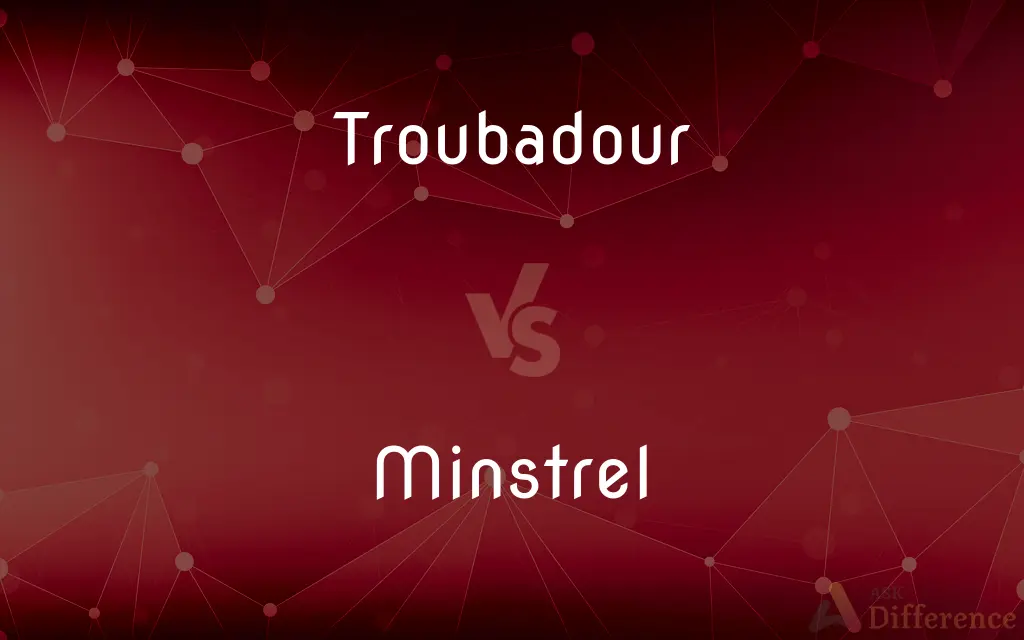Troubadour vs. Minstrel — What's the Difference?
By Urooj Arif & Maham Liaqat — Updated on March 28, 2024
Troubadours were medieval lyric poets in southern France, composing and performing songs of courtly love, whereas minstrels were versatile medieval entertainers who sang, played instruments, and performed across Europe.

Difference Between Troubadour and Minstrel
Table of Contents
ADVERTISEMENT
Key Differences
Troubadours emerged in the 11th century in Occitania, now southern France, as composers and performers of lyric poetry focusing on themes of chivalry and courtly love. They wrote in Occitan, and their art was often tied to the courts of nobles. Minstrels, on the other hand, were more general entertainers found throughout medieval Europe, performing songs, music, and stories for various audiences, from courts to public squares, and were not restricted to any one language or region.
While troubadours were often of noble birth or at least closely associated with the aristocracy, allowing them to focus on the art of poetry and music, minstrels were typically of lower social status. Minstrels traveled extensively, offering their services wherever there was demand, thus playing a crucial role in spreading news and cultural ideas across regions. This distinction highlights the troubadours' focus on artistic expression within elite circles, whereas minstrels served both as entertainers and informal newsbearers to wider audiences.
Troubadours were known for their intricate compositions, both musically and lyrically, often accompanied by instruments like the lute. Their work was highly stylized, adhering to complex forms of poetry and music that celebrated the ideals of courtly love. Minstrels, while also skilled musicians and storytellers, were more versatile in their performances, incorporating a variety of instruments, comedic acts, and even acrobatics into their repertoire to entertain diverse crowds.
The legacy of troubadours is preserved in their written compositions, which have been influential in the development of Western poetry and music. The troubadour tradition inspired later literary movements and had a lasting impact on European culture. Conversely, the minstrel tradition, being more varied and widespread, contributed to the evolution of folk music and popular entertainment in medieval Europe, influencing storytelling and performance styles across different cultures.
In terms of cultural significance, troubadours played a key role in shaping the concept of romantic love that pervades Western literature and thought. Their emphasis on the ideals of chivalry and the refined expression of love set standards that influenced later romantic literature. Minstrels, with their broader scope of performance, helped to foster a shared cultural heritage among disparate European communities, bridging social and geographical divides through their itinerant performances.
ADVERTISEMENT
Comparison Chart
Origin
11th century, Occitania (southern France)
Medieval Europe, various regions
Themes
Courtly love, chivalry
Diverse, including love, heroism, comedy
Social Status
Often noble or aristocratic
Lower social status, itinerant performers
Language
Occitan
Various, depending on the region
Performance Style
Lyric poetry set to music
Music, storytelling, comedy, acrobatics
Influence
European poetry and music, courtly love
Folk music, storytelling, entertainment
Audience
Nobility, courts
Broad, including courts and public
Instrumentation
Lute, harp
Varied, including lutes, drums, flutes
Compare with Definitions
Troubadour
A medieval lyric poet composing and performing in Occitan about courtly love.
The troubadour serenaded the court with verses of unrequited love.
Minstrel
A medieval traveling musician and entertainer.
The minstrel brought news and songs from distant lands.
Troubadour
A composer of courtly music.
As a troubadour, his compositions elevated the ideals of chivalry.
Minstrel
An itinerant performer of the medieval period.
The minstrel’s life was a constant journey from one town to another.
Troubadour
A noble or aristocratic poet and musician.
The troubadour, a knight, expressed his valor and love through song.
Minstrel
A performer of diverse acts, from music to comedy.
The minstrel’s repertoire delighted everyone at the fair.
Troubadour
An artist of the troubadour tradition.
His work as a troubadour was renowned across southern France.
Minstrel
A storyteller through song.
The minstrel recounted heroic tales with his music.
Troubadour
A creator of intricate lyrical poetry.
The troubadour’s verses were masterpieces of medieval literature.
Minstrel
A contributor to the folk tradition.
Minstrels played a key role in shaping medieval folk music.
Troubadour
A troubadour (English: , French: [tʁubaduʁ] (listen); Occitan: trobador [tɾuβaˈðu] (listen)) was a composer and performer of Old Occitan lyric poetry during the High Middle Ages (1100–1350). Since the word troubadour is etymologically masculine, a female troubadour is usually called a trobairitz.
Minstrel
A minstrel was a medieval European entertainer. Originally describing any type of entertainer such as a musician, juggler, acrobat, singer or fool, the term later, from the sixteenth century, came to mean a specialist entertainer who sang songs and played musical instruments.
Troubadour
A French medieval lyric poet composing and singing in Provençal in the 11th to 13th centuries, especially on the theme of courtly love.
Minstrel
A medieval entertainer who traveled from place to place, especially to sing and recite poetry.
Troubadour
One of a class of 12th-century and 13th-century lyric poets in southern France, northern Italy, and northern Spain, who composed songs in langue d'oc often about courtly love.
Minstrel
A lyric poet.
Troubadour
A strolling minstrel.
Minstrel
A musician.
Troubadour
An itinerant composer and performer of songs in medieval Europe; a jongleur or travelling minstrel.
Minstrel
A performer in a minstrel show.
Troubadour
One of a school of poets who flourished from the eleventh to the thirteenth century, principally in Provence, in the south of France, and also in the north of Italy. They invented, and especially cultivated, a kind of lyrical poetry characterized by intricacy of meter and rhyme, and usually of a romantic, amatory strain.
Minstrel
(historical) Originally, an entertainer employed to juggle, play music, sing, tell stories, etc.; a buffoon, a fool, a jester; later, a medieval (especially travelling) entertainer who would recite and sing poetry, often to their own musical accompaniment.
Troubadour
A singer of folk songs
Minstrel
(by extension)
Minstrel
Any lyric poet, musician, or singer.
Minstrel
One of a troupe of entertainers, often a white person who wore black makeup (blackface), to present a so-called minstrel show, being a variety show of banjo music, dance, and song (now sometimes regarded as racist).
Minstrel
An amphetamine tablet, typically black, or black and white, in colour.
Minstrel
(transitive) To play (a tune on a musical instrument); to sing (a song).
Minstrel
(intransitive) To act as a minstrel; to entertain by playing a musical instrument, singing, etc.
Minstrel
In the Middle Ages, one of an order of men who subsisted by the arts of poetry and music, and sang verses to the accompaniment of a harp or other instrument; in modern times, a poet; a bard; a singer and harper; a musician.
Minstrel
A singer of folk songs
Minstrel
A performer in a minstrel show
Minstrel
Celebrate by singing, in the style of minstrels
Common Curiosities
How did troubadours and minstrels influence modern entertainment?
Troubadours influenced Western poetry and music, especially the concept of romantic love, while minstrels contributed to the evolution of folk music and storytelling.
Did troubadours travel like minstrels?
While some troubadours traveled, they were more closely associated with noble courts, unlike minstrels who were itinerant by nature.
What language did troubadours and minstrels perform in?
Troubadours wrote and sang in Occitan, while minstrels performed in various languages, depending on their region.
Could women be troubadours or minstrels?
Yes, there were female troubadours known as trobairitz, and women could also be minstrels, though they were less common.
What happened to the troubadour and minstrel traditions?
The troubadour tradition declined with changing political and social conditions, but their influence persists in literature and music. Minstrelsy evolved, influencing modern folk and popular entertainment.
What distinguished troubadours from minstrels?
Troubadours were often of noble birth, focusing on courtly love and chivalry in their compositions, while minstrels were versatile entertainers performing for diverse audiences.
How did the social status of troubadours and minstrels affect their art?
Troubadours’ noble or aristocratic status allowed them to focus on refined themes of love and chivalry, while minstrels’ lower status and itinerant lifestyle led to a more diverse and accessible form of entertainment.
Did troubadours compose their own music?
Yes, troubadours were both poets and composers, often performing their own works.
What instruments did troubadours and minstrels play?
Troubadours favored the lute and harp, while minstrels used a wide range of instruments, including flutes, drums, and lutes.
Did troubadours and minstrels perform in castles?
Troubadours often performed in noble courts and castles, while minstrels could perform in a variety of venues, including castles, marketplaces, and public squares.
Were minstrels part of guilds or organizations?
In later medieval periods, some minstrels were organized into guilds, but many operated independently.
Were minstrels considered artists or entertainers?
Minstrels were seen as entertainers, skilled in music, storytelling, and comedy, catering to a broad audience.
How were minstrels viewed by society?
Minstrels were popular among all social classes for their entertainment value, though they were sometimes viewed as vagabonds.
What is the legacy of troubadours in modern culture?
The legacy of troubadours is evident in romantic poetry and music, influencing genres that emphasize lyrical expression and themes of love.
How did the themes of troubadour and minstrel songs differ?
Troubadour songs focused on courtly love and chivalry, while minstrel songs covered a broader range of themes, including love, heroism, and everyday life.
Share Your Discovery

Previous Comparison
Enlist vs. Inlist
Next Comparison
What vs. WhenAuthor Spotlight
Written by
Urooj ArifUrooj is a skilled content writer at Ask Difference, known for her exceptional ability to simplify complex topics into engaging and informative content. With a passion for research and a flair for clear, concise writing, she consistently delivers articles that resonate with our diverse audience.
Co-written by
Maham Liaqat













































